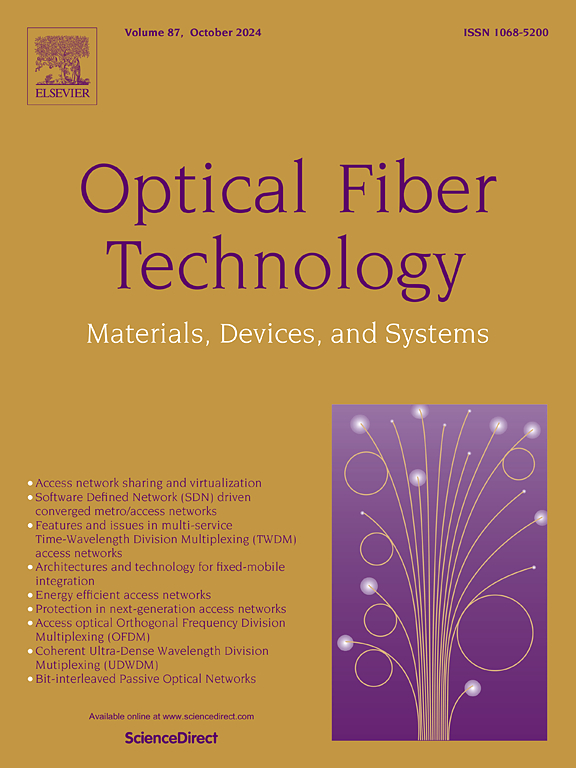A novel Vernier effect fiber optic sensor with tunable M-factor via effective refractive index adjustment
IF 2.7
3区 计算机科学
Q2 ENGINEERING, ELECTRICAL & ELECTRONIC
引用次数: 0
Abstract
In this paper, we present the design and fabrication of a Vernier effect sensor with a tunable magnification factor (M-factor). We define a set of limiting conditions to specify the applicable range of the sensing and reference extrinsic Fabry-Perot interferometer (EFPI) cavity lengths (Ls and Lr) and their effective refractive indices (ns and nr), which ensure the stability of the Vernier effect and reliable signal demodulation. Simulations are conducted to validate the proposed limiting conditions by analyzing spectral characteristics under varying relative length differences. The simulation results confirm the effectiveness of the proposed framework. To make the M-factor tunable and extend the feasible range for length design, we propose a method to adjust the M-factor by tuning the effective refractive index (RI) of the EFPI. This adjustment of RI affects the detuning factor, which in turn allows precise control of the M-factor. Various combinations of Ls, ns and nr are simulated to assess their impact on the Vernier effect and to investigate the applicable range of these parameters. Finally, we fabricate the proposed M-factor tunable Vernier effect sensor and verify the theoretical predictions through experiments. The experimental results show that by using the fabricated EFPI and the RI range provided by saline solutions, an M-factor tuning range of 6.5 to 9.5 is achieved. These results closely match the simulations, confirming the feasibility and reliability of the proposed framework for practical sensor applications. Building on these findings, the sensor could broaden its applicable range through targeted design, offering greater flexibility for various applications.
一种基于有效折射率调节的m因子可调的游标效应光纤传感器
在本文中,我们提出了一个具有可调放大因子(m因子)的游标效应传感器的设计和制造。为了保证游标效应的稳定性和信号解调的可靠性,我们定义了一组限定条件,以限定传感和参考外源法布里-珀罗干涉仪(EFPI)腔长(Ls和Lr)及其有效折射率(ns和nr)的适用范围。通过分析不同相对长度差下的光谱特性,对所提出的限制条件进行了仿真验证。仿真结果验证了该框架的有效性。为了使m因子可调,并扩大长度设计的可行范围,我们提出了一种通过调整EFPI的有效折射率来调节m因子的方法。RI的这种调整影响失谐因子,这反过来又允许精确控制m因子。模拟了Ls、ns和nr的各种组合,以评估它们对游标效应的影响,并研究了这些参数的适用范围。最后,我们制作了m因子可调游标效应传感器,并通过实验验证了理论预测。实验结果表明,利用制备的EFPI和生理盐水提供的RI范围,可以实现6.5 ~ 9.5的m因子调谐范围。这些结果与仿真结果非常吻合,证实了所提出的框架在实际传感器应用中的可行性和可靠性。在这些发现的基础上,传感器可以通过有针对性的设计扩大其适用范围,为各种应用提供更大的灵活性。
本文章由计算机程序翻译,如有差异,请以英文原文为准。
求助全文
约1分钟内获得全文
求助全文
来源期刊

Optical Fiber Technology
工程技术-电信学
CiteScore
4.80
自引率
11.10%
发文量
327
审稿时长
63 days
期刊介绍:
Innovations in optical fiber technology are revolutionizing world communications. Newly developed fiber amplifiers allow for direct transmission of high-speed signals over transcontinental distances without the need for electronic regeneration. Optical fibers find new applications in data processing. The impact of fiber materials, devices, and systems on communications in the coming decades will create an abundance of primary literature and the need for up-to-date reviews.
Optical Fiber Technology: Materials, Devices, and Systems is a new cutting-edge journal designed to fill a need in this rapidly evolving field for speedy publication of regular length papers. Both theoretical and experimental papers on fiber materials, devices, and system performance evaluation and measurements are eligible, with emphasis on practical applications.
 求助内容:
求助内容: 应助结果提醒方式:
应助结果提醒方式:


